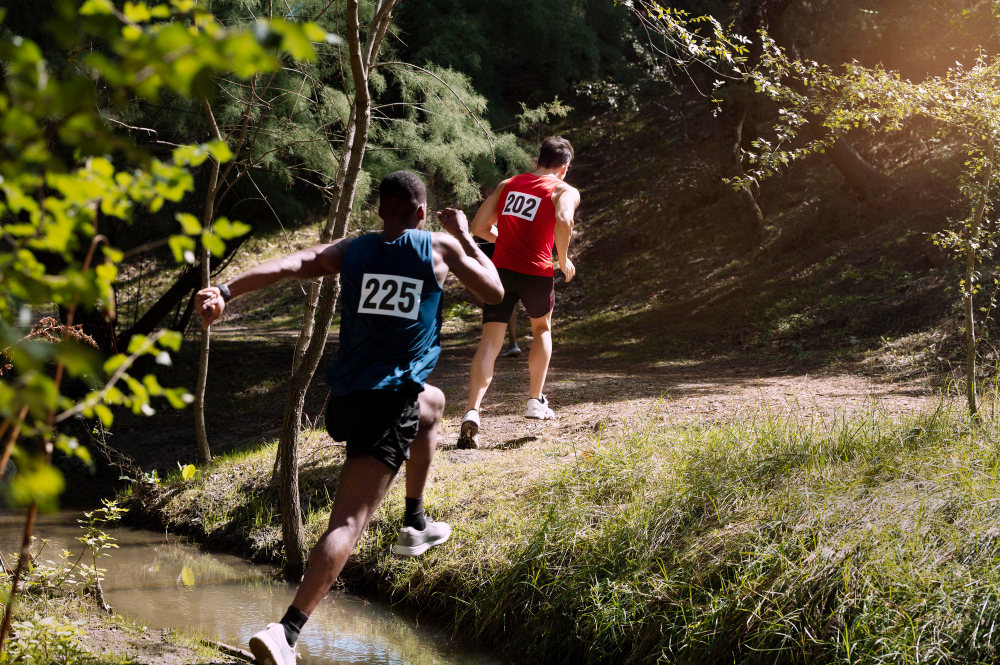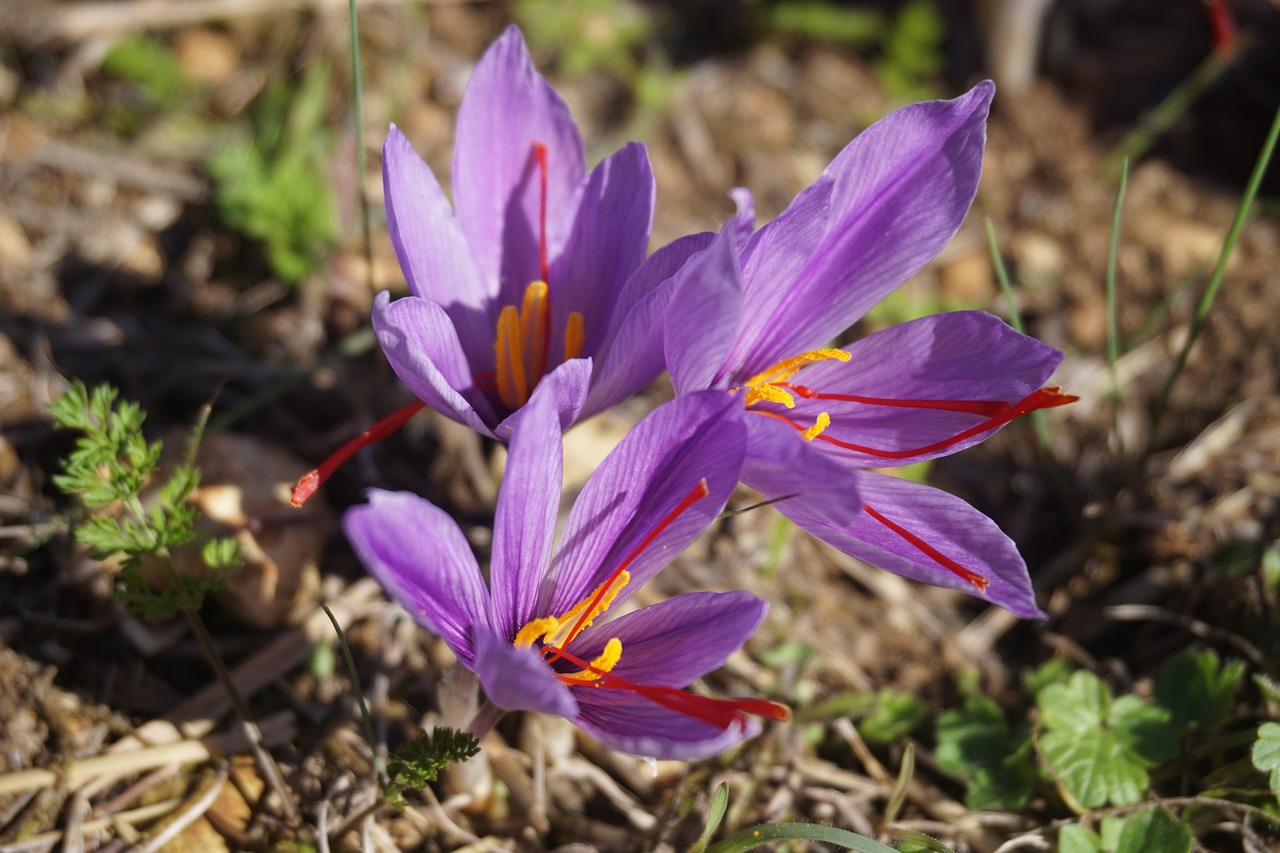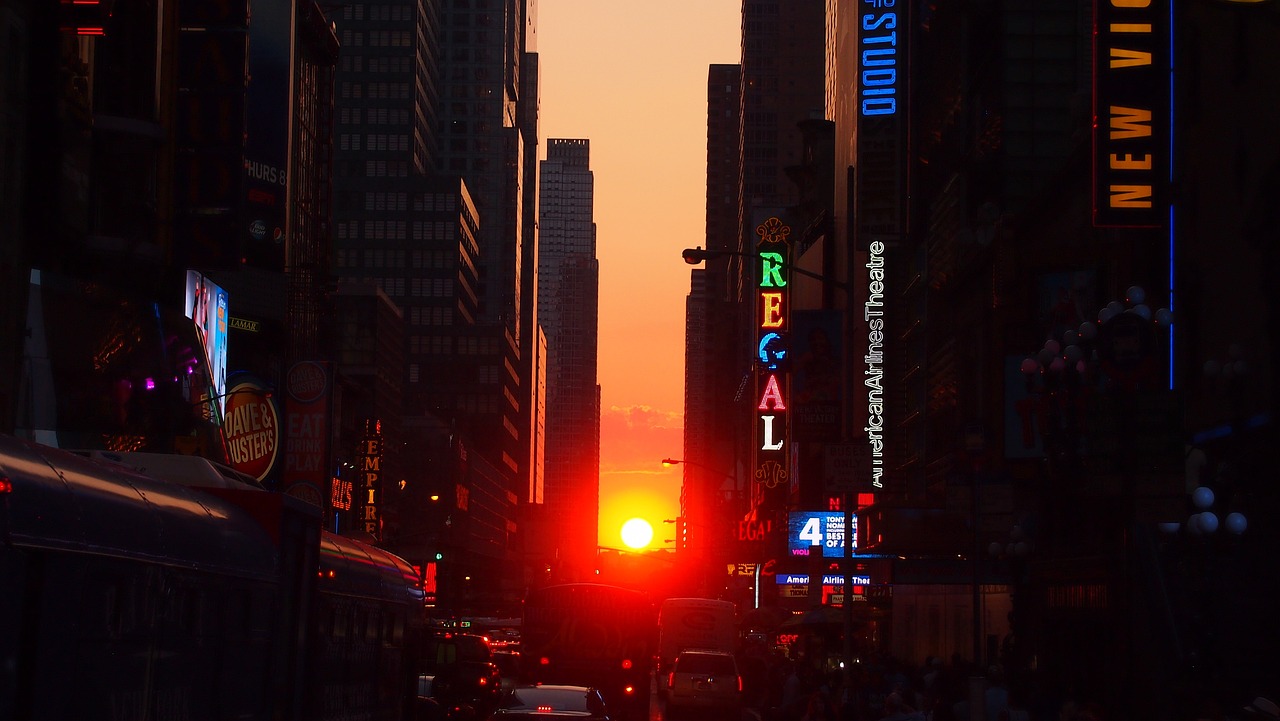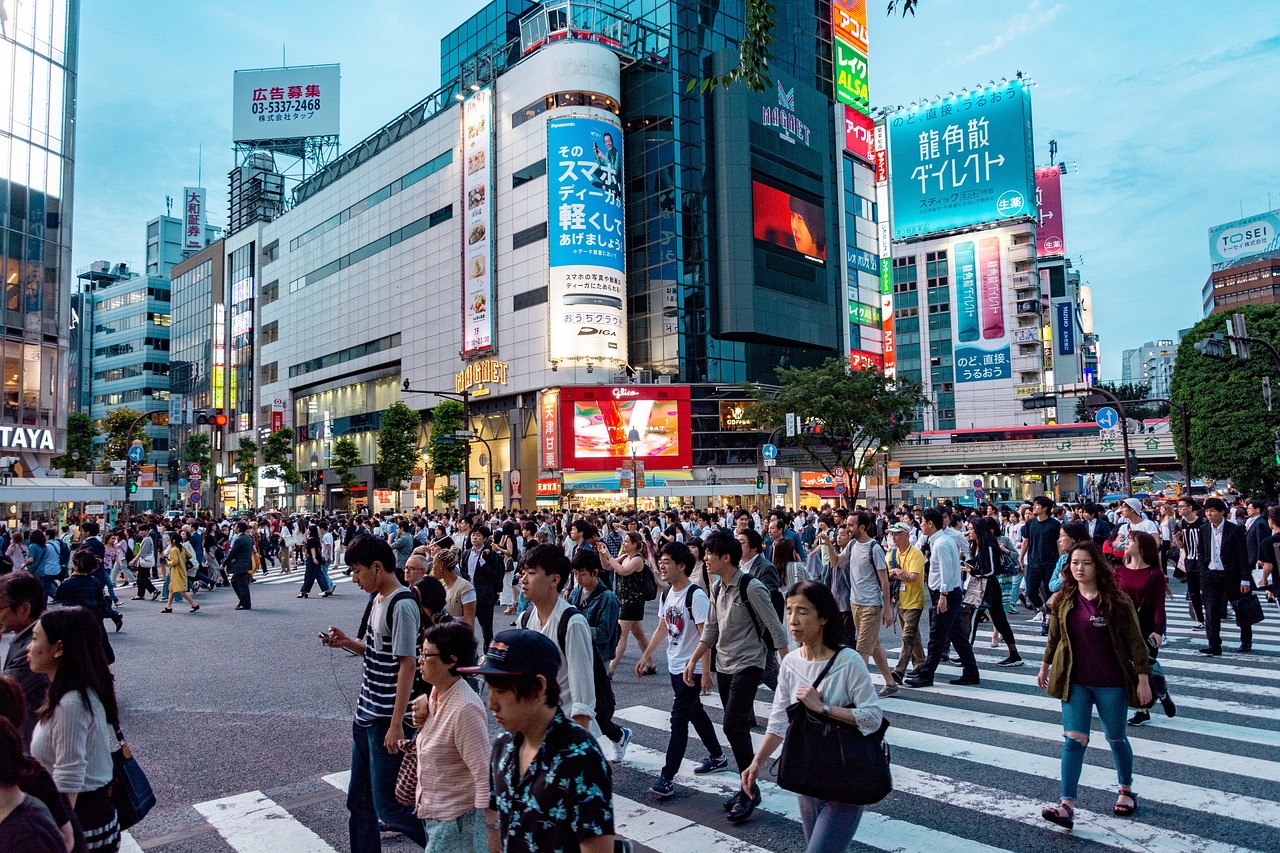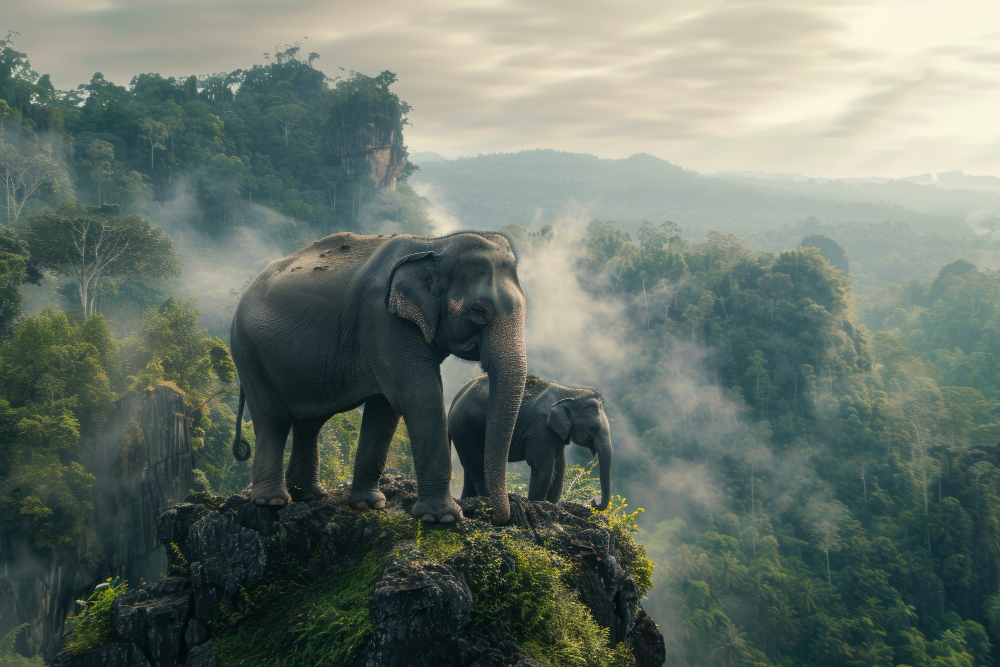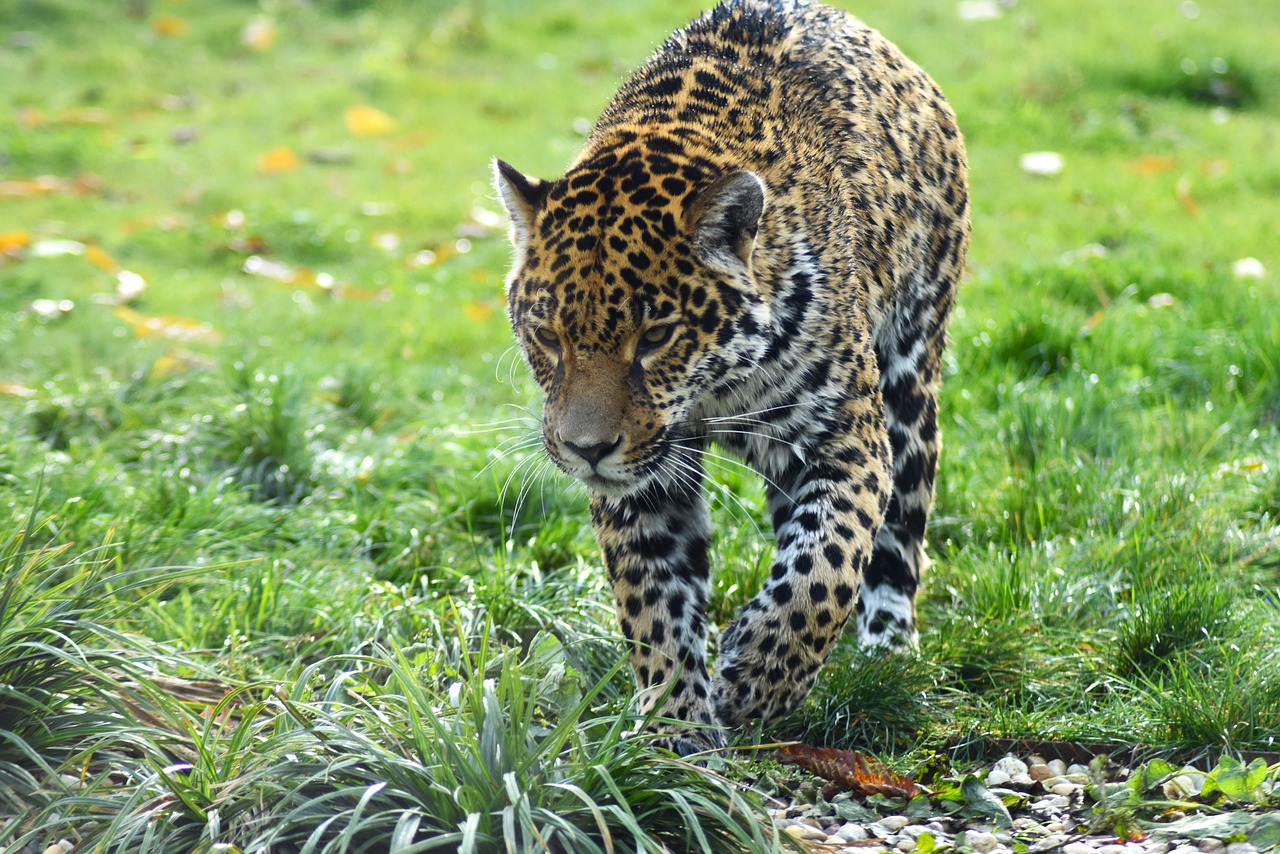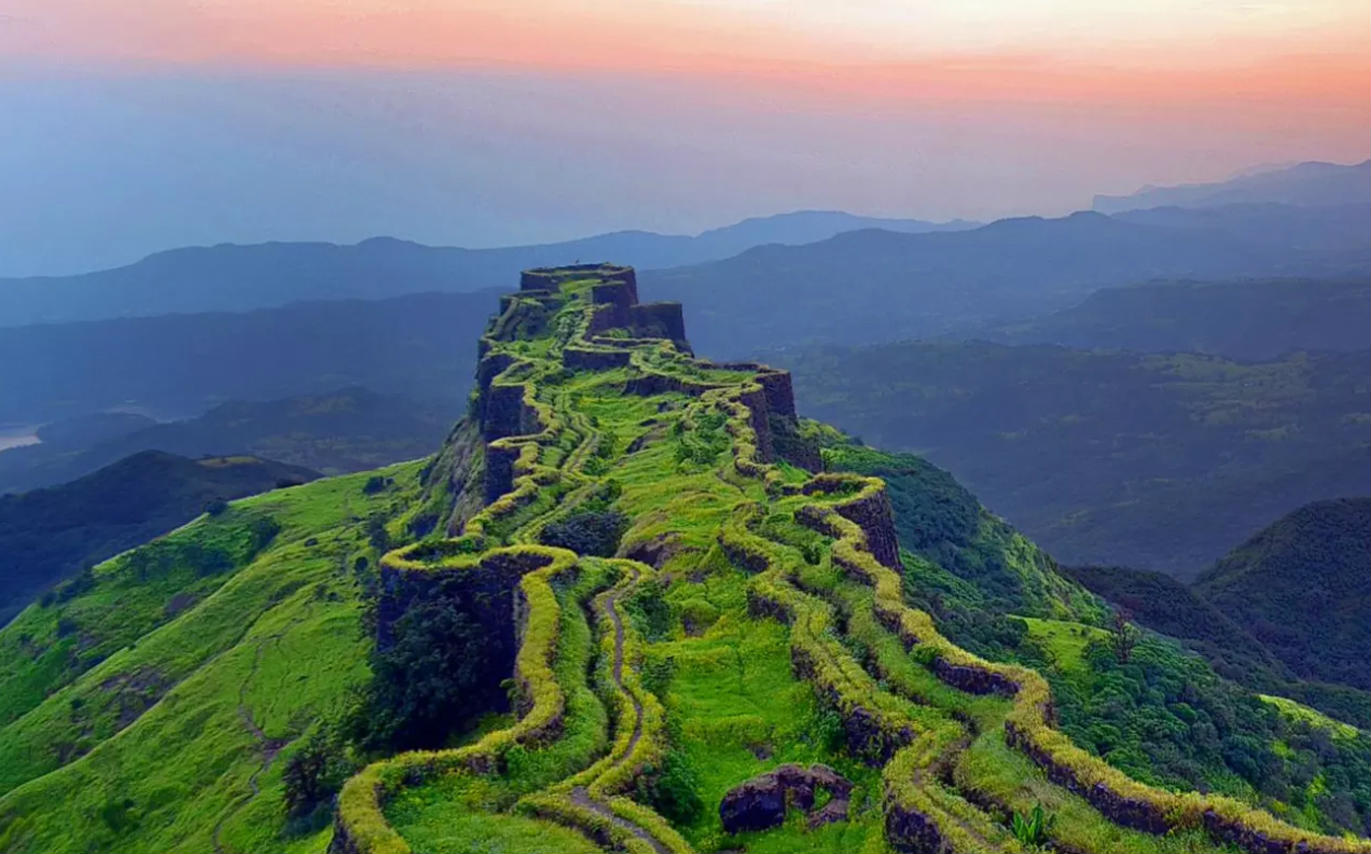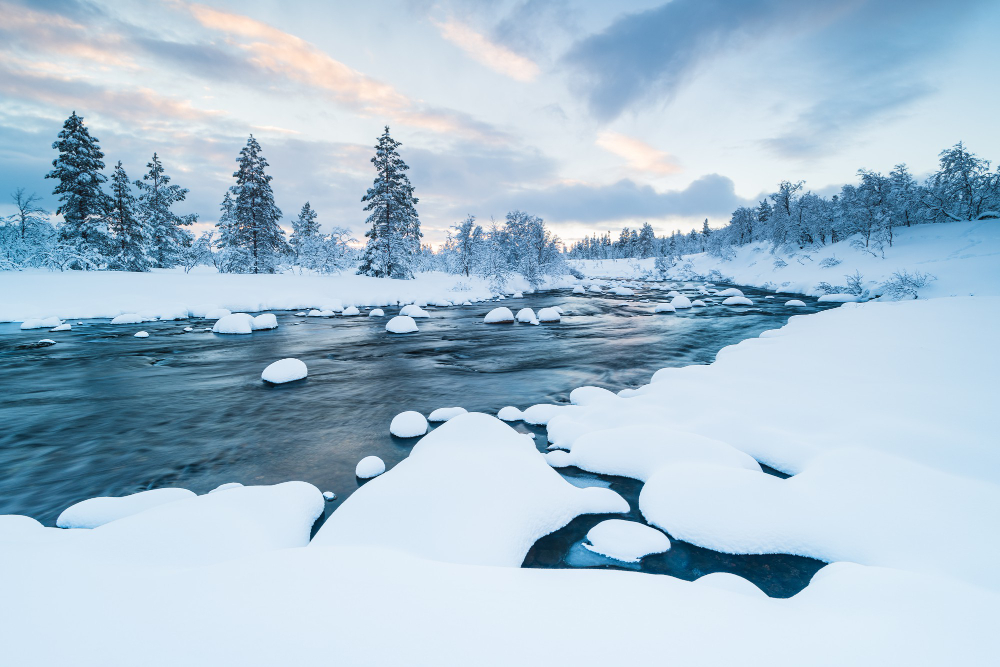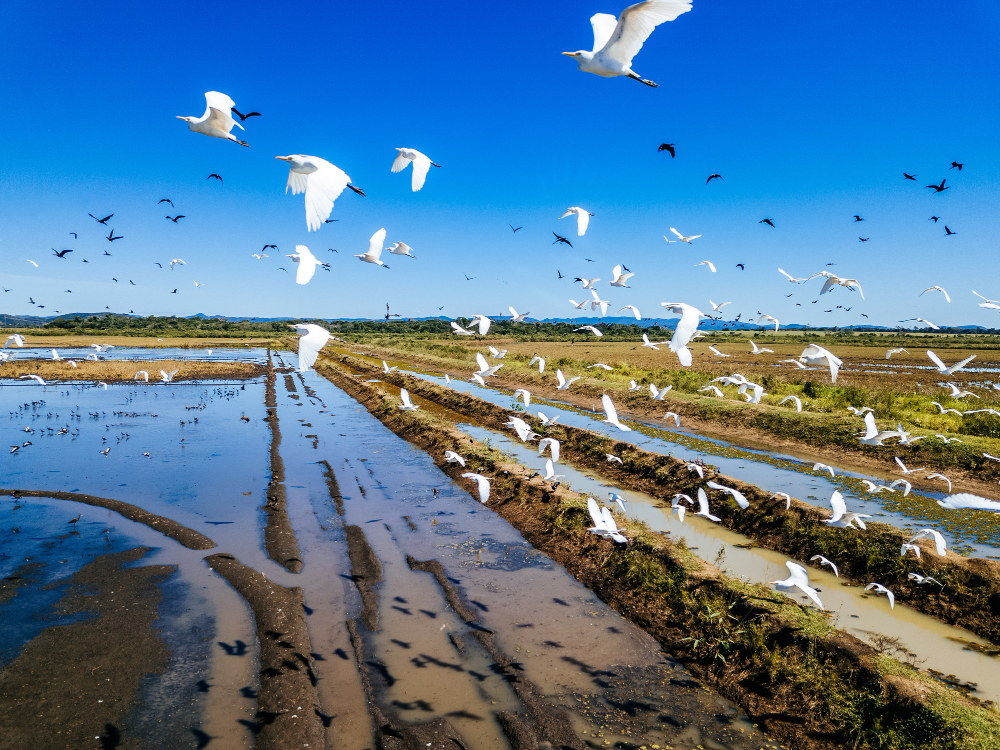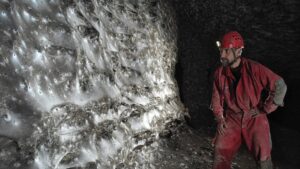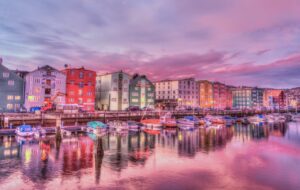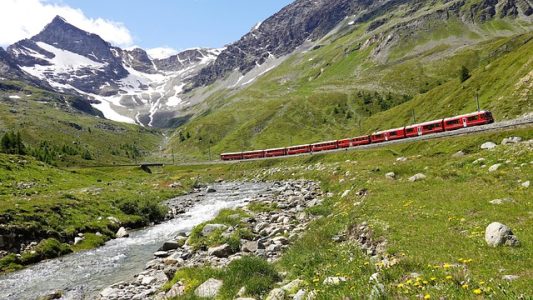 Pin
Pin Image by Iso Tuor from Pixabay
The thing about trains, you see, is that they possess a particular kind of enchantment that other forms of travel simply cannot claim. It isn’t the speed—goodness knows, planes are faster—nor is it the independence that comes with driving yourself along winding roads. No, what makes train travel so utterly captivating is the way it lets you exist between two worlds: the cozy, almost womb-like comfort of your compartment, and the grand, ever-changing theater of landscape that unfolds beyond your window like the turning pages of a beloved storybook.
Scattered across our world, tucked into mountain ranges and stretched along coastlines, threading through valleys and crossing great expanses of wilderness, there exist railway journeys that transcend their practical purpose. These aren’t merely conveyances to get you from Point A to Point B—they are experiences unto themselves, adventures written in steel and steam and the rhythmic poetry of wheels upon rails. The 10 most beautiful train rides in the world await those brave enough to choose the slower path, the scenic route, the journey that matters as much as the destination. They promise something rather precious in our hurried age: time to simply watch, to wonder, and to let the world’s beauty seep into your bones without rushing past in a blur. So pour yourself something warm, claim that window seat with the best view, and prepare to discover why some journeys are worth savoring.
Table of Contents
1. The Glacier Express, Switzerland—Where Mountains Touch Heaven
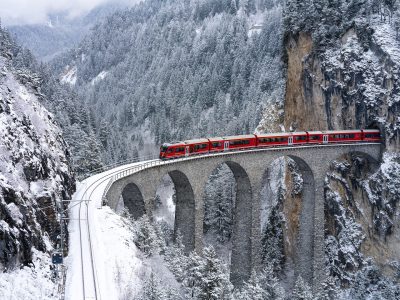 Pin
Pin Photo by Artem Shestakov
Switzerland’s Glacier Express doesn’t hurry, and that’s rather the point. This crimson ribbon of a train takes eight glorious hours to traverse just 180 miles, winding its way from Zermatt to St. Moritz through the heart of the Swiss Alps. The locals call it “the slowest express train in the world,” and they say it with the sort of fond pride usually reserved for a delightfully eccentric aunt. Through panoramic windows that curve up into the ceiling—designed specifically so you won’t miss a single snow-capped peak—you’ll watch as the train crosses 291 bridges and burrows through 91 tunnels, each one a feat of engineering that seems to defy the very mountains themselves.
The landscape shifts like a kaleidoscope turned by some unseen hand. Deep gorges give way to alpine meadows dotted with wooden chalets that look as though they’ve been plucked from a fairy tale. The Landwasser Viaduct appears quite suddenly, a six-arched limestone bridge that carries you 213 feet above the valley floor before plunging directly into the mountain face. In winter, everything wears a cloak of pristine white, while summer paints the hillsides in wildflowers so vibrant they hardly seem real. You’ll pass the Rhine Gorge—Switzerland’s answer to the Grand Canyon—and climb to the Oberalp Pass at over 6,670 feet, where even the clouds seem to travel below you. It’s the sort of journey that makes you understand why people once believed mountains were the dwelling places of gods.
2. The Trans-Siberian Railway, Russia—A Journey Through Time Itself
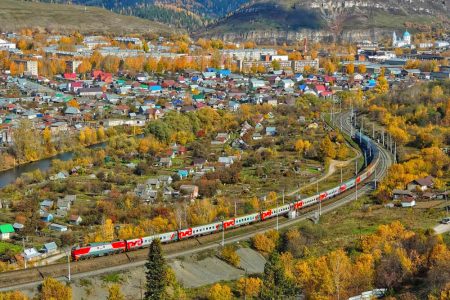 Pin
Pin Photo by Altai-Touristic
There exists no railway quite like the Trans-Siberian, and perhaps there never will be again. This is not merely a train ride—it’s a crossing of continents, a week-long odyssey that spans 5,772 miles from Moscow’s ornate spires to Vladivostok’s Pacific shores. The numbers alone stagger the imagination: you’ll traverse eight time zones, cross 87 cities and towns, and spend roughly seven days watching the largest country on Earth roll past your window. But numbers, however impressive, cannot capture what it feels like to surrender a full week of your life to the steady rhythm of rails, to watch your fellow passengers become a temporary family, to feel yourself slip into a sort of trance where the journey becomes your entire world.
The landscape reveals Russia’s soul in layers, like peeling back the pages of an epic novel. You’ll glide past the golden domes of ancient monasteries, through Siberian taiga forests so vast and unbroken they seem to stretch into eternity, and alongside Lake Baikal—the deepest lake on the planet, holding one-fifth of the world’s fresh water in its ancient basin. The birch trees stand like white sentinels, their trunks glowing against the dark pines. In summer, the endless daylight of the northern latitudes plays tricks with time itself, while winter transforms the world into a crystalline wonderland where temperatures plunge so low that your breath becomes ice before it reaches the ground. You’ll share meals with strangers who become friends, drinking tea from traditional Russian glasses held in ornate metal holders, and somewhere between Moscow and the Pacific, you’ll discover what it means to truly slow down and exist within a journey rather than simply endure it.
3. The Rocky Mountaineer, Canada—Through Nature's Cathedral
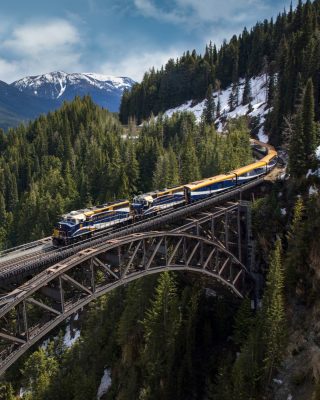 Pin
Pin Photo courtesy of Journeyscape
Canada’s Rocky Mountaineer operates on a rather wonderful principle: train travel ought to happen during daylight hours only, because missing the scenery while you sleep would be nothing short of criminal. So unlike most long-distance trains, this one tucks you into proper hotels each night, then sets off again the next morning when the light is perfect for witnessing the Canadian Rockies in all their untamed glory. The route between Vancouver and the mountain towns of Banff or Jasper takes you through British Columbia and Alberta, where the mountains don’t merely rise—they erupt from the earth in jagged peaks that scrape the belly of the sky, their faces streaked with glaciers that have been carving stone for millennia.
The train follows rivers that run the color of crushed turquoise, fed by glacial melt that carries rock flour in suspension, creating that otherworldly blue-green hue you won’t find anywhere else on Earth. You’ll wind through valleys where black bears forage along the tracks, seemingly unbothered by your passing, and bald eagles circle overhead like they’re patrolling their kingdom. The GoldLeaf Service carriages feature glass-domed roofs, so you can tilt your head back and watch the mountain peaks slide past above you—it’s rather like being inside a snow globe, except the scenery outside is magnificently real. Spiral tunnels twist inside mountains, gaining elevation through sheer engineering cleverness, while trestle bridges carry you over chasms where one false step would mean a very long fall indeed. The Rockies have a way of making you feel simultaneously insignificant and profoundly connected to something larger than yourself, a sensation that settles into your chest and stays there long after the journey ends.
4. The West Highland Line, Scotland—Where Legends Ride the Rails
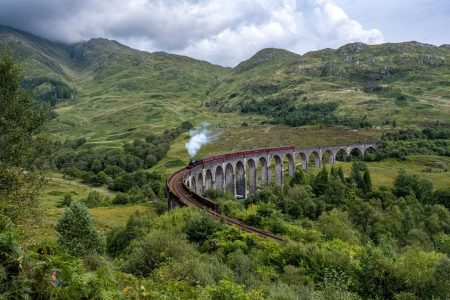 Pin
Pin Photo courtesy of Delphine Soria
Scotland’s West Highland Line runs from Glasgow to Mallaig, and if you’re a certain sort of person—the kind who grew up reading books about young wizards—you might recognize one particular stretch as the route the Hogwarts Express takes in those beloved films. But long before it carried fictional students to magical schools, this railway was carving through some of the most hauntingly beautiful landscape in Britain, where mist clings to hillsides like ghosts refusing to leave, and lochs reflect mountains so perfectly you cannot tell where reality ends and its reflection begins. The journey takes about five hours, though it feels both longer and shorter than that, the way time behaves strangely when you’re utterly absorbed in something beautiful.
The Glenfinnan Viaduct stands as the line’s crown jewel—a sweeping curve of twenty-one arches that carries trains across a valley with such elegant defiance of gravity that it takes your breath away. Below, Loch Shiel stretches into the distance, its dark waters holding secrets and stories centuries old. The train climbs past Rannoch Moor, a vast expanse of peat bog and lonely beauty that feels like the end of the world, where red deer roam and the wind speaks in ancient tongues. You’ll pass through tiny stations that serve villages so remote they measure distances not in miles but in degrees of isolation. The western coast eventually reveals itself, bringing with it the salt smell of the Atlantic and views of islands floating on the horizon like dreams half-remembered. This is Scotland at its most raw and real, the Scotland of poets and warriors, of highland cattle with their shaggy coats and expressions of perpetual bemusement, of landscapes that have watched centuries pass and remained fundamentally unchanged by human ambition.
5. The Bergen Railway, Norway—Above the Clouds and Through the Snow
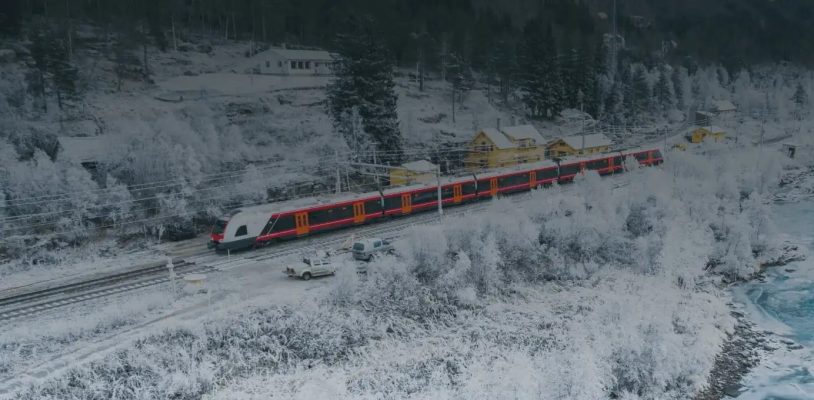 Pin
Pin Photo courtesy of Rail Ninja
Norway’s Bergen Railway earns its reputation as one of Europe’s most remarkable engineering achievements by doing something rather audacious: it climbs to 4,058 feet above sea level, making it the highest mainline railway in Northern Europe. The journey between Oslo and Bergen takes roughly seven hours, and for a significant portion of that time, you’re traveling across the Hardangervidda plateau—a windswept, treeless expanse that exists above the tree line, where only the hardiest mosses and lichens can survive. This is a landscape that time forgot, or perhaps more accurately, a landscape that exists outside of time altogether, where the forces of ice and wind have shaped the earth into something both desolate and devastatingly beautiful.
The train departs from Oslo through gentle farmland and forests, and you might think you know what to expect. But then, gradually, the trees begin to shrink and thin, as though the altitude is draining the life from them, until finally they disappear altogether and you find yourself in another world entirely. Snow covers the ground for much of the year here, even in summer, creating vast white plains broken only by the occasional lake or boulder. The light behaves differently at this altitude—sharper, clearer, as though the air itself has been polished. You’ll pass tiny stations painted in traditional Norwegian red, lonely outposts where it’s difficult to believe anyone actually lives, yet smoke curls from chimneys and children sometimes wave from cabin windows. The descent into Bergen brings you through valleys carved by ancient glaciers, past waterfalls that plunge hundreds of feet down sheer rock faces, and finally into the historic harbor town where wooden buildings cluster around the waterfront like colorful seabirds come to roost. It’s a journey that reminds you how recently humans learned to master mountains, and how tentative that mastery truly remains.
6. The Coastal Pacific, New Zealand—Where Ocean Meets Rail
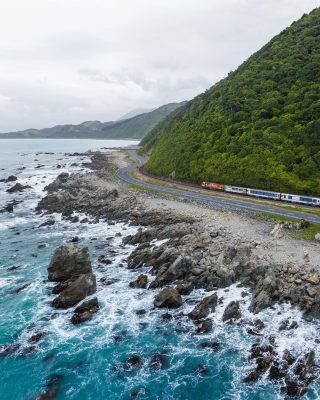 Pin
Pin Photo courtesy of Pure New Zealand
New Zealand’s Coastal Pacific railway runs along the eastern edge of the South Island, connecting Picton to Christchurch in a journey that takes roughly five hours but feels like flipping through a photography book where every single page deserves to be framed. What makes this route particularly special is how intimately it hugs the coastline—there are stretches where the tracks run so close to the Pacific Ocean that you could practically reach out and trail your fingers in the surf, if the windows opened and physics allowed such things.
The Kaikōura coast, in particular, offers something you won’t find on many railways: the chance to spot whales breaching in the distance, their massive bodies launching from the water in displays of power that seem to defy everything you thought you knew about what creatures that size could do.
The mountains rise almost directly from the sea here, creating a dramatic collision of ecosystems where snow-capped peaks tower over beaches where seals lounge like sunbathers who’ve claimed the best spots and refuse to move. The train winds through tunnels carved into cliff faces, emerges onto bridges that span river mouths where fresh water meets salt, and passes through the wine country of Marlborough, where endless rows of grapevines march up hillsides in orderly green battalions. You’ll cross the Wairau River on a bridge that seems almost too delicate for the job, and roll through plains where sheep outnumber humans by ratios that sound like mathematical jokes but are actually census facts. The light in New Zealand has a particular quality—something about the clean air and the way the country sits isolated in the southern Pacific—that makes colors appear more saturated, more vivid, as though someone has turned up the contrast on reality itself.
7. The Maharajas' Express, India—A Palace on Wheels
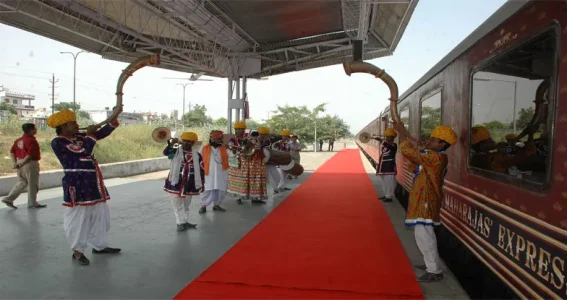 Pin
Pin Photo courtesy of Tra-Eminent India tours
India’s Maharajas’ Express doesn’t simply transport you across the subcontinent—it wraps you in the sort of opulence that once belonged exclusively to princes and potentates, the kind of luxury that makes you walk a bit taller and speak a bit softer, as though you’ve temporarily joined some exclusive club where velvet curtains and crystal chandeliers are considered basic necessities. This is train travel as it existed in a more glamorous age, when journeys were events unto themselves and arriving at your destination slightly disappointed that the ride had ended was considered perfectly normal. The routes vary, but they all wind through Rajasthan and beyond, connecting the great monuments and cities of northern India in week-long journeys where your cabin becomes a moving hotel suite complete with LCD televisions, Wi-Fi, and bathrooms more spacious than some London flats.
The real magic, though, happens outside your luxurious cocoon. The train carries you past villages where life continues much as it has for centuries, where women in brilliantly colored saris balance water jugs on their heads with the sort of grace that makes you wonder if gravity works differently here. You’ll see the Taj Mahal at sunrise, when the white marble glows pink and gold like something not quite of this world, and explore the amber-hued forts of Jaipur, where peacocks strut through courtyards and the walls still whisper stories of battles fought and romances that ended in tragedy. The countryside shifts from desert landscapes where camels plod along dusty roads to fertile plains where water buffalo wallow in muddy ponds, perfectly content with their lot in life. Evening brings you back to the train for dinner prepared by chefs who understand that food is not merely fuel but a form of storytelling, each dish layered with spices that have traveled trade routes as ancient as the railways are modern.
8. The Bernina Express, Switzerland and Italy—A Red Thread Through the Alps
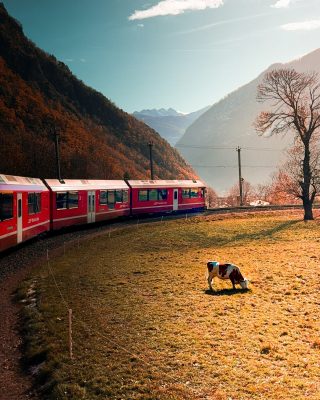 Pin
Pin Photo courtesy of Hamza Bensaid
The Bernina Express stitches together Switzerland and Italy with a crimson thread of carriages that climb higher than seems remotely sensible, crossing the Alps without the aid of cog wheels or rack railways—just ordinary tracks, extraordinary engineering, and what one suspects must be a fair bit of nerve on the part of the engineers who designed it. This UNESCO World Heritage railway ascends from the palm trees and Italian villas of Tirano, climbs to the frozen realm of the Bernina Pass at 7,391 feet, then descends into the Swiss resort town of Chur, all in roughly four hours of travel that compresses multiple climate zones into a single journey.
The panoramic windows wrap around you in a way that makes you feel less like a passenger and more like a bird gliding through mountain passes that were, until relatively recently, considered impassable for much of the year.
The route crosses the Landwasser Viaduct and spirals through the Brusio Circular Viaduct, a perfect nine-arched spiral where the train literally loops around itself, gaining elevation in a maneuver that looks like something a child might build with toy tracks, except this version is hewn from stone and has been carrying actual trains since 1908. You’ll pass glaciers that glow an impossible blue where ancient ice catches the sunlight, their surfaces cracked and crevassed like the skin of sleeping dragons. Lakes appear in shades of turquoise and emerald, their colors created by minerals ground so fine by glacial movement that they remain suspended in the water, scattering light in ways that seem to violate the normal rules of how water ought to look. Small stations cling to mountainsides at angles that suggest optimism bordering on delusion, yet they’ve stood there for over a century, welcoming passengers who arrive already breathless from the views and the altitude both.
9. The Eastern & Oriental Express, Southeast Asia—Through the Heart of the Tropics
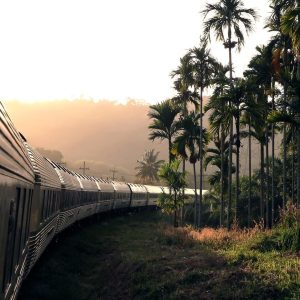 Pin
Pin Photo courtesy of Edwin Hart
The Eastern & Oriental Express resurrects the golden age of travel and sets it loose in Southeast Asia, where the humidity makes everything shimmer and the jungle presses so close to the tracks that you can hear the birds calling from the dining car. This is train travel as theater, as romance, as a deliberate rejection of the notion that getting somewhere quickly matters more than savoring every mile along the way. The journey between Singapore and Bangkok takes three days and two nights, winding through Malaysia and Thailand in a procession of polished wood panels, brass fittings, and observation cars where you can stand with a drink in hand, watching the world slide past at a pace that allows you to actually see it. The passengers tend toward a certain type—those who understand that luxury isn’t about speed or efficiency but about time spent well, in beautiful surroundings, with strangers who often become friends by journey’s end.
The landscape transforms as you travel north from Singapore’s modern skyline into the rural heartland where rice paddies stretch toward horizons and water buffalo stand knee-deep in mud, chewing thoughtfully as your train passes. You’ll cross the River Kwai on a bridge rebuilt after the original—the one from that famous film—was destroyed, and the history settles heavy in the air for a moment before the jungle swallows you again. Villages appear and disappear, flashes of corrugated tin roofs and wooden houses on stilts, children waving from doorways with the unselfconscious enthusiasm of those who still find trains exciting. The heat never quite releases its grip, but the air conditioning keeps your cabin comfortable while ceiling fans in the dining car spin lazily overhead, more for atmosphere than actual cooling. Meals are served on fine china, and the dishes blend European sophistication with Southeast Asian flavors—a culinary conversation between cultures that mirrors the journey itself, moving between worlds while belonging fully to neither.
10. The Ghan, Australia—Across the Red Centre's Ancient Heart
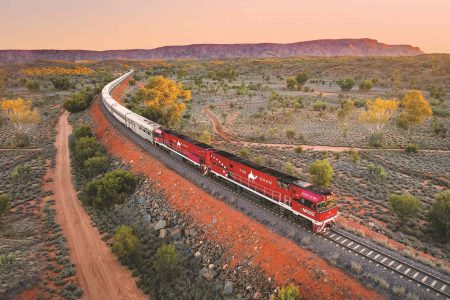 Pin
Pin Photo courtesy of Journey Beyond Rail
Australia’s Ghan takes its name from the Afghan cameleers who once traversed these same routes before railways existed, when crossing the continent meant weeks of slow travel through landscapes so harsh and unforgiving that merely surviving the journey counted as success. Now the train makes that crossing in considerably more comfort, running 1,851 miles from Adelaide on the southern coast to Darwin in the tropical north, bisecting the entire continent in a three-day journey that reveals Australia’s extraordinary emptiness—and in that emptiness, a strange and compelling beauty that gets under your skin like red dust. The train itself stretches nearly half a mile long when fully loaded, a silver serpent sliding through the Outback with a persistence that speaks to human stubbornness in the face of a landscape that never particularly wanted us here.
The Red Centre lives up to its name spectacularly. The earth glows rust and orange and crimson, colors so saturated they seem painted on rather than naturally occurring, stretching unbroken to horizons so distant you can actually perceive the curve of the Earth. You’ll stop at Alice Springs, that improbable town plunked down in the middle of nowhere, where the nearest ocean sits roughly a thousand miles in any direction you care to choose. The train pauses at Katherine for excursions into gorges carved by rivers that run only when rain decides to visit, which it does infrequently and dramatically. Termite mounds rise like ancient monuments, some taller than a grown human, their builders having constructed air-conditioned cities while humans were still learning to control fire. As you travel north, the landscape gradually softens, the red earth giving way to tropical vegetation, until finally you arrive in Darwin where the air hangs thick with moisture and the crocodiles in the harbor remind you that Australia’s reputation for hosting creatures that could cheerfully kill you remains well-earned. It’s a journey through deep time, across land that Aboriginal peoples have called home for sixty thousand years, and that perspective—that sense of how recently Europeans arrived in this ancient place—colors everything you see.
Bonus Track: The TranzAlpine, New Zealand—Through the Backbone of the South Island
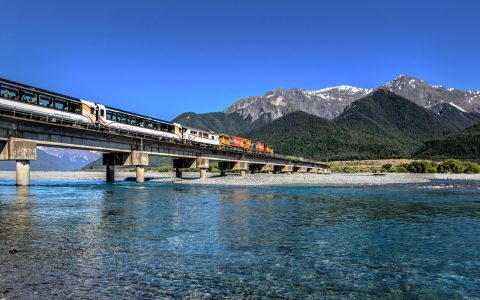 Pin
Pin Photo courtesy of Haka Tours New Zealand
The TranzAlpine railway accomplishes something rather remarkable in just under five hours: it crosses New Zealand’s South Island from the Pacific Ocean to the Tasman Sea, threading through the Southern Alps in a journey that compresses more geological drama into a single day than most places manage in a week. Starting from Christchurch on the east coast, the train heads inland across the Canterbury Plains, where the land lies flat and pastoral, sheep grazing in paddocks that stretch toward mountains still distant enough to seem like a painted backdrop. But trains, unlike sheep, don’t stop at the foothills, and soon enough you’re climbing into the Alps proper, where the landscape shifts from gentle to dramatic with the abruptness of a curtain being pulled aside to reveal what was hidden all along.
The Arthur’s Pass region is where the journey earns its reputation. The track climbs through gorges carved by rivers that run pale blue-green with glacial melt, their waters moving fast enough that you can see the power in them even from your window. Beech forests cling to mountainsides at angles that suggest they’re holding on through sheer determination, and waterfalls appear with such frequency that you stop trying to photograph each one and simply let them become part of the visual rhythm of the journey. The train spirals through tunnels and across viaducts, including the Staircase Viaduct where the track zigzags up the mountainside in a series of switchbacks that feel slightly mad but have been working perfectly well since 1923. At Arthur’s Pass itself, you’re surrounded by peaks that scrape the sky, and if you’re lucky enough to travel on a clear day, the snow-covered summits glow against the blue like something out of a dream that’s trying very hard to convince you it’s real. The descent into Greymouth on the west coast brings you through native podocarp forests and past old gold-mining settlements, reminders that humans have been finding reasons to cross these mountains for as long as there’s been something worth crossing them for. The Tasman Sea eventually appears, grey and moody and utterly different in character from the Pacific you left behind, as though the mountains don’t just divide the island geographically but climatically and emotionally as well.
FAQs
It depends on what you’re after! Winter transforms Alpine routes into snow-covered wonderlands, while summer brings wildflowers and longer daylight. Autumn offers stunning foliage, and spring means fewer crowds with nature awakening.
For luxury trains like the Maharajas’ Express or Eastern & Oriental, yes—sometimes a year ahead. Regular scenic routes like the TranzAlpine or Bergen Railway often allow booking just weeks before, though popular seasons fill quickly.
Absolutely! Most scenic railways welcome families. The constantly changing views keep young ones entertained, and many trains offer family compartments. Just pack snacks, games, and prepare for toilet queues during busy periods.
Many routes allow this! The Glacier Express, Rocky Mountaineer, and Trans-Siberian all permit stopover tickets. It’s actually recommended—you’ll experience more than just the view from your window, and towns along these routes are often magical.
The West Highland Line and Bergen Railway offer spectacular scenery at regular ticket prices—genuine bargains. If you’re after luxury, the Eastern & Oriental Express provides exceptional value considering accommodation, meals, and excursions are included in the fare.
